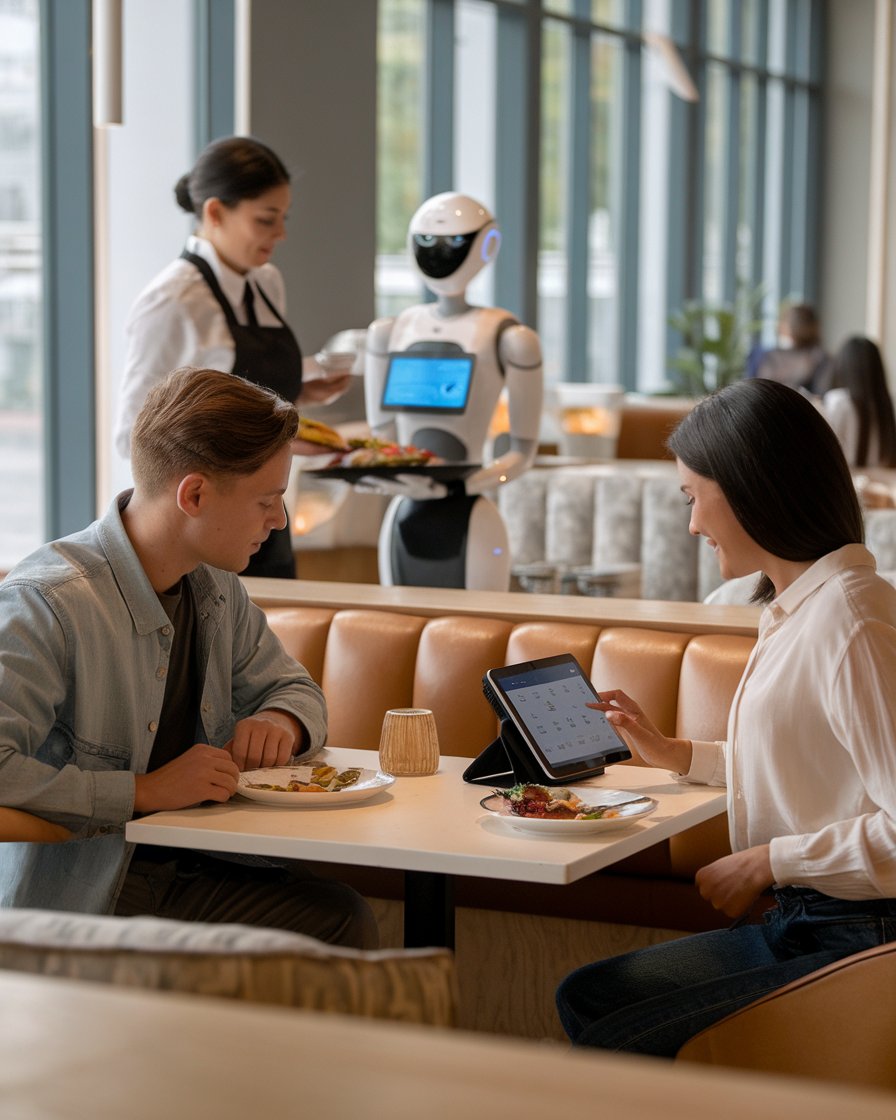Introduction
Restaurant automation is transforming the restaurant industry, making it easier for restaurant owners to manage their operations efficiently. By utilizing restaurant automation tools, restaurants can automate various tasks like order processing, inventory tracking, and marketing efforts. These tools available allow automated restaurants to streamline operations, reducing the need for manual intervention and improving overall efficiency. Moreover, the integration of marketing automation and restaurant technology helps enhance customer experience by offering personalized services, thus driving repeat business and improving profitability.
Incorporating the right automation tools is essential for any restaurant management team looking to optimize their food delivery systems and back-of-house operations. The use of advanced automation in the restaurant industry ensures that customers and restaurant staff benefit from seamless service delivery. By leveraging restaurant automation software, businesses can stay ahead of the competition and ensure that their business operations are not only efficient but also scalable in the long run.
Key Takeaways
- Restaurant automation is transforming the industry by enhancing efficiency and improving the customer experience.
- Automation tools significantly reduce labor costs by handling repetitive tasks, allowing staff to focus on critical areas.
- Automation enhances customer satisfaction through faster, more accurate service and personalized experiences.
- POS systems and inventory management automation streamline operations and reduce errors, improving overall business efficiency.
- Self-service kiosks and online ordering systems are key trends driving the future of restaurant automation.
- Personalization through automation strengthens customer relationships, driving repeat business and long-term success.
The Impact of Restaurant Automation on the Restaurant Industry
Restaurant automation is revolutionizing the restaurant industry, offering new ways to enhance efficiency and improve the customer experience. By integrating automation tools, restaurants can streamline various aspects of their operations, such as order processing, inventory management, and payment systems. These technologies reduce the need for manual tasks, allowing restaurant staff to focus more on customer service and less on repetitive duties. As automation in restaurants becomes more widespread, it is transforming how restaurant businesses operate, making it possible to handle peak business hours with ease, reduce wait times, and improve overall order accuracy. The shift towards automation is not just a trend; it’s a critical development in the modern restaurant industry.
Key Strategies to Automate Restaurant Operations and Streamline Your Business
1. Integrate Cloud-Based POS Systems
Implementing a cloud-based POS system is crucial for modernizing restaurant operations. These systems offer seamless integration of order processing, payment handling, and inventory management, allowing real-time data access and better decision-making.
2. Automate Inventory and Supply Chain Management
Automation tools can significantly improve inventory and supply chain management. By tracking inventory levels in real-time and automating reorders, restaurants can prevent stockouts, reduce waste, and maintain optimal inventory levels.
3. Enhance Customer Experience with Automated Marketing
Automated marketing tools help personalize the customer experience by sending targeted promotions, loyalty rewards, and personalized recommendations. This not only enhances customer satisfaction but also drives repeat business.
4. Streamline Front-of-House Operations
Using self-service kiosks and digital menus can streamline front-of-house operations. These tools reduce wait times, improve order accuracy, and allow staff to focus more on enhancing the overall dining experience.
5. Optimize Back-of-House Processes
Automation in the kitchen, such as using kitchen display systems and automated cooking equipment, ensures consistency, reduces errors, and improves efficiency in food preparation.
How Automation Reduces Labor Costs in Restaurants
One of the significant impacts of restaurant automation is the reduction of labor costs. Automation tools take over repetitive and time-consuming tasks, such as order taking and payment processing, which allows restaurant staff to focus on more critical areas like customer service. By reducing the need for extensive manual labor, restaurants can operate more efficiently with fewer staff members, lowering overall labor expenses. This cost-saving benefit is particularly crucial in a highly competitive industry where margins are often tight. With automation, restaurants can maintain a high level of service while controlling costs, ultimately contributing to improved profitability.
Enhancing Customer Experience Through Automation
Automation also plays a crucial role in enhancing the customer experience in restaurants. Automated systems, such as digital menus and self-service kiosks, allow customers to place orders quickly and accurately, reducing wait times and minimizing errors. This streamlined process not only improves customer satisfaction but also encourages repeat business. Additionally, automation enables personalized experiences, such as customized recommendations and loyalty programs, further enriching the dining experience. As customers increasingly seek convenience and efficiency, the role of automation in delivering a superior customer experience becomes more vital.
How Automation Tools Streamline Restaurant Operations
Automation tools are essential in streamlining restaurant operations by automating key tasks that typically require significant manual effort. For example, automated ordering systems and cloud-based POS systems reduce the chances of human error and improve the speed of service. Inventory management becomes more efficient with automation, as these tools can track inventory levels in real-time, prompting reorders before stock runs out. Additionally, front-of-house automation tools, such as self-service kiosks and digital menus, allow customers to place orders quickly, reducing wait times and enhancing the overall customer experience. By leveraging these tools, restaurant owners can optimize their operations, save time, and focus on delivering a better experience for customers.
Case Study: Transforming Operations with Comprehensive Automation
A fast-casual restaurant chain with over 50 locations faced challenges with long wait times, inconsistent order accuracy, and high labor costs. By implementing a cloud-based POS system integrated with automated inventory management and self-service kiosks, the chain streamlined its operations significantly. The automation tools reduced human error, improved service speed, and allowed for real-time inventory tracking, which minimized stockouts and waste. As a result, the restaurant chain saw a 20% reduction in labor costs and a 15% increase in customer satisfaction, proving the effectiveness of a comprehensive automation strategy in the restaurant industry.
The Role of POS Systems in Streamlining Operations
Point of Sale (POS) systems are central to streamlining restaurant operations. A modern, cloud-based POS system integrates various functions, including order processing, payment, and inventory management, into one seamless platform. This integration reduces the need for multiple systems and minimizes the risk of errors. POS systems also provide valuable insights into sales trends and inventory levels, helping restaurant owners make informed decisions. By automating these essential tasks, POS systems free up time for restaurant staff to focus on enhancing the customer experience and improving service efficiency.
Automating Inventory Management for Better Efficiency
Inventory management is another area where automation tools significantly streamline operations. Automated inventory management systems track stock levels in real-time, alerting restaurant owners when it’s time to reorder supplies. This not only prevents stockouts but also reduces waste by ensuring that perishable items are used before they expire. Additionally, these systems can analyze sales data to predict future inventory needs, allowing for more accurate ordering. By automating inventory management, restaurants can operate more efficiently, reduce costs, and minimize the risk of running out of critical supplies during peak business hours.
Embrace Automation: Benefits of Automating Your Restaurant
Embracing automation in your restaurant offers numerous benefits that can significantly improve both front-of-house and back-of-house operations. Automation software, like kitchen display systems and order management systems, helps to ensure that orders are processed accurately and efficiently. This not only improves order accuracy but also reduces the workload on kitchen staff, allowing them to focus on food quality. In addition to operational benefits, automation also positively impacts the financial side of the business by reducing labor costs and increasing productivity. Implementing the right automation solutions in your restaurant can lead to better management of resources, enhanced customer satisfaction, and ultimately, greater profitability in the restaurant business.
Improving Order Accuracy with Kitchen Display Systems
Kitchen display systems are a vital automation tool that enhances order accuracy in restaurants. These systems replace traditional paper tickets with digital displays, ensuring that kitchen staff receives clear, precise orders. The digital interface minimizes the risk of miscommunication and allows for real-time updates, reducing the likelihood of errors. As a result, orders are prepared correctly the first time, improving customer satisfaction and reducing food waste. Implementing kitchen display systems is a key step in leveraging automation to improve operational efficiency and maintain high standards of service in your restaurant.
Reducing Wait Times with Self-Service Kiosks
Self-service kiosks are becoming increasingly popular in restaurants as a way to reduce wait times and streamline the ordering process. These kiosks allow customers to place their orders directly, eliminating the need to wait for a server. The automation of the ordering process not only speeds up service but also allows for greater customization of orders, catering to individual customer preferences. By reducing wait times and offering a more personalized experience, self-service kiosks enhance customer satisfaction and can lead to increased sales, making them a valuable addition to any restaurant’s automation strategy.
“The first rule of any technology used in a business is that automation applied to an efficient operation will magnify the efficiency.” – Bill Gates
Top Restaurant Automation Trends in the Restaurant Business
The restaurant business is rapidly evolving with the rise of new automation trends that are reshaping how operations are managed. One of the most significant trends is the use of automation systems that integrate various aspects of restaurant operations, from order processing to inventory management. Cloud-based POS systems and digital ordering platforms are becoming standard, allowing for seamless integration of online ordering with in-house systems. Another trend is the use of automation in marketing strategies, where tools help personalize customer experiences and increase repeat business. These trends highlight the importance of staying updated with the latest automation technologies to maintain a competitive edge in the restaurant industry.
The Rise of Online Ordering Systems
Online ordering systems are one of the most significant trends in restaurant automation. These systems allow customers to place orders from their mobile devices or computers, providing convenience and flexibility. Restaurants that integrate online ordering with their in-house POS systems can manage orders more efficiently, reducing errors and speeding up service. Online ordering also opens up new revenue streams by making it easier for customers to order takeout or delivery. As more customers turn to digital platforms for their dining needs, having a robust online ordering system is essential for staying competitive in the modern restaurant business.
Personalizing Customer Experience with Automation
Personalization is a growing trend in restaurant automation, with tools that tailor the dining experience to individual customer preferences. Automation systems can track customer behavior, such as past orders and dining habits, to offer personalized recommendations and promotions. Loyalty programs can also be automated, rewarding customers based on their unique preferences and encouraging repeat business. By using automation to personalize the customer experience, restaurants can build stronger relationships with their customers, increase satisfaction, and drive repeat visits, all of which contribute to long-term business success.
[lasso rel=”amazon-29″ id=”10216″]
Conclusion
In conclusion, restaurant automation is a game-changer in the industry, offering significant advantages in efficiency, customer satisfaction, and overall business operations. By integrating automation tools into your restaurant, you can streamline everything from order processing to inventory management, reducing the need for manual labor and improving accuracy. The benefits of restaurant automation extend beyond just the front-of-house; it also enhances back-of-house automation, ensuring seamless operations across all aspects of your business. Whether it’s using restaurant accounting software or selecting the right automation tools for your restaurant, embracing these technologies will help you stay ahead of the competition and drive long-term success.
As automation becomes more prevalent, it’s clear that adopting these cutting-edge restaurant automation solutions is crucial for any modern restaurant. From efficient table management to improved restaurant equipment usage, the ability to streamline operations and increase profitability through automation is no longer a luxury but a necessity in today’s competitive market.













